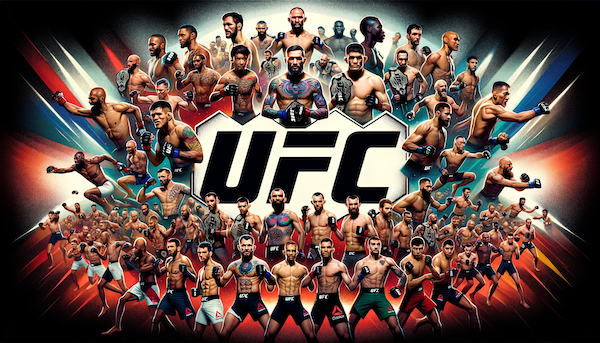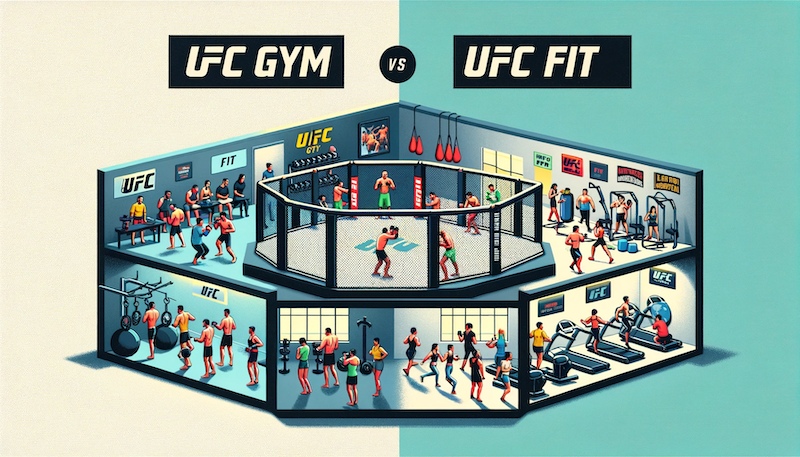
In the fast-changing world of mixed martial arts (MMA), the UFC stands on its own at the front, casting a long shadow over its competitors.
Since its inception in 1993, the UFC has spearheaded the popularity and growth of MMA globally and set the gold standard for the sport.
As we look to the future, there are 8 compelling reasons to believe the UFC will continue to dominate the MMA landscape for decades to come.
Contents
Why the UFC Will Dominate MMA For Decades
The UFC will dominate MMA for decades because of its unparalleled brand recognition, media domination, substantial financial resources, strong leadership via Dana White, global expansion strategy, ability to pay and attract top-fighting talent, and first-mover advantage.
Let’s take a closer look at the 8 reasons.
1. Unmatched Brand Recognition

The UFC has become synonymous with MMA, enjoying a level of brand recognition unparalleled in the sport.
This brand loyalty isn’t just a testament to its past successes but a foundation for future dominance.
Fans across the globe associate MMA with the UFC, a connection that new and existing competitors find challenging to break.
2. Financial Muscle
The financial prowess of the UFC is a critical factor in its dominance. With substantial resources at its disposal, the UFC outstrips its competitors in marketing, fighter development, fighter attraction, and event production.
Ownership by Endeavor Group Holdings
The acquisition of the UFC by Endeavor Group Holdings, a leading global media and entertainment company, has provided the UFC with robust financial backing.
This support is crucial in scaling operations, expanding globally, and competing against other promotions like PFL and ONE Championship.
Superior Pay-Per-View Sales
The UFC leads the industry in pay-per-view sales, a significant revenue stream. Its events consistently outperform those of other promotions in terms of both sales and viewership, thanks to high-profile fights and effective marketing.
Record-Breaking Gate Receipts
The UFC’s ability to sell tickets and fill arenas contributes substantially to its revenue. It often sets records for gate receipts, especially for marquee events, underscoring its popularity and the demand for live MMA events.
Lucrative Sponsorship Deals
The UFC’s sponsorship agreements, including those with major brands like Reebok and Venum, are a testament to its marketability and appeal to advertisers.
These deals not only bring in direct revenue but also enhance the UFC’s brand value.
Online Merchandising
The UFC’s online store, offering a wide range of UFC-branded products, taps into the loyalty of its fan base, creating an additional revenue stream.
Strong Online Media Presence
The UFC’s digital footprint, including a substantial YouTube channel, plays a significant role in its financial success.
This platform not only generates advertising revenue but also serves as a marketing tool to engage fans and promote events.
UFC Fight Pass
Perhaps most importantly, UFC Fight Pass, the organization’s subscription-based streaming service, represents a steady and growing income stream.
At $10 per month, with a large subscriber base, Fight Pass is a critical component of the UFC’s business model, offering exclusive content and access to live events.
No other MMA organizations match the offerings of UFC Fight Pass. With UFC Fight Pass, subscribers have access to an extensive library of over 20,000 fights from various promotions, along with the live streaming of events from over 30 combat sports promotions.
Sustainable Fighter Compensation and Business Model
The UFC’s financial strength allows it to pay its fighters more money and offer bigger contracts than other MMA promotions.
The UFC, being the most profitable and revenue-generating MMA promotion, can afford to attract and retain the most elite MMA fighters globally.
This is not just about offering lucrative paydays but also about creating a stable and long-term career path for fighters.
In contrast, some MMA promotions, like ONE Championship, PFL, and formerly PRIDE, have managed to provide short-term financial equality to their highest-paid stars.
However, PRIDE’s strategy of high spending to attract top fighters without a sustainable business model led to its eventual bankruptcy. This highlights the risks of prioritizing short-term gains over long-term viability.
On the other hand, the UFC’s approach, while often criticized due to its profitability and longevity, has proven to be more sustainable.
The organization pays more to its biggest stars and maintains this practice over time, thanks to its successful business model.
3. Roster of Stars

The UFC’s ability to attract and retain top fighting talent is unmatched. By offering fighters a bigger stage and potentially larger paydays, the UFC has assembled a roster that represents 80%+ of the most elite talent globally.
This concentration of talent ensures that the UFC remains the go-to destination for fans seeking high-quality, competitive fights.
And while other MMA promotions like PFL and ONE Championship have the odd superstar, on average, the UFC has a much higher level of MMA on offer, as well as more superstars.
4. Global Footprint
The UFC’s global footprint is a testament to its strategic expansion and commitment to becoming a truly international sport. It’s one of the reasons the UFC will dominate MMA for decades.
Here are some key examples of how the UFC has extended its reach globally:
UFC Performance Institutes
The UFC has invested in building state-of-the-art Performance Institutes (PIs) around the world. The UFC PI in Las Vegas, USA, serves as the flagship facility, offering fighters access to advanced training, health, and wellness resources.
In China, the UFC opened a PI in Shanghai, significantly expanding its presence in Asia. This facility serves local fighters and acts as a training hub for talent across the region.
Additionally, the UFC is developing a PI in Mexico, further cementing its commitment to nurturing talent in diverse geographies, as well as supporting its fighters from different countries.
UFC Gym and UFC Fit Franchises

The UFC has also expanded its brand through the UFC Gym and UFC Fit franchises. Combined, there are over 150 locations around the world.
These gyms offer fitness programs and training in MMA techniques to the general public, spreading the sport’s popularity beyond just the fan base.
This network of gyms helps in promoting the UFC brand and MMA as a lifestyle, reaching a wider audience globally.
International Events and Localization
The UFC has held events in numerous countries, adapting its content to local markets.
This includes translating commentary and featuring local fighters and cultural elements, making events more appealing to regional audiences.
Countries that the UFC recently expanded to include France (2023), Saudi Arabia (2024), and Abu Dhabi (though the first event there was in 2010). The UFC is aiming to expand to Africa soon.
Media and Broadcasting Deals
The UFC has secured broadcasting deals with various international networks, ensuring that its events are accessible worldwide.
This global media presence is crucial for attracting new fans and maintaining the interest of existing ones.
Some of their broadcasting deals include:
- ESPN in the United States
- BT Sport in the United Kingdom and Ireland
- TSN and RDS in Canada
- Globo in Brazil
- Main Event and Fetch TV in Australia
- DAZN in Germany and Italy
Beyond these regional deals, the UFC’s streaming service, UFC Fight Pass, offers live events (including UFC events), a vast library of past fights, and original programming globally.
This platform is essential for reaching international markets where traditional broadcasting deals aren’t as extensive.
Digital Platforms and Social Media
The UFC’s use of digital platforms, including its significant YouTube channel presence and UFC Fight Pass, has been instrumental in reaching a global audience and keeping them in the UFC’s world.
These platforms allow fans from all over the world to access content, regardless of their location.
5. Strong Leadership

Under the leadership of Dana White, the UFC has navigated the choppy waters of the sports industry with remarkable acumen.
This strong leadership is crucial in making strategic decisions that have propelled the UFC to its current heights and will be pivotal in maintaining its dominance.
And while Dana White won’t be president of the UFC forever, he’s set an example of success for the next UFC president.
The fact he’s been the UFC president since 2001, for over 23 years, shows that the UFC makes intelligent decisions concerning recruitment.
They make sure they have the right person for each role in the company and don’t rush decisions. In all likelihood, the next UFC president is currently working alongside Dana White so they can learn the role fully.
6. Investment in the Future
The UFC’s strategic approach to securing its future dominance in MMA is evident in its comprehensive investment in fighter development and cutting-edge training facilities.
This forward-thinking strategy is about actively shaping the future of the sport. By identifying and nurturing emerging talent, the UFC is laying the groundwork for the next generation of MMA stars, ensuring the organization’s vibrancy and competitive edge for years to come.
State-of-the-Art Training Facilities
UFC Performance Institutes: The UFC’s Performance Institutes are more than just gyms; they’re hubs of innovation and excellence in fighter training, recovery, and health.
The flagship facility in Las Vegas sets a global standard, while the Shanghai Institute expands this excellence to Asia. The upcoming PI in Mexico reflects the UFC’s commitment to global talent development.
Talent Discovery and Development Programs
The Ultimate Fighter (TUF): TUF has become a cornerstone of the UFC’s talent development strategy.
While American-based, this reality series has evolved into a global phenomenon with regional versions like TUF Latin America and TUF China, each uncovering new talents and bringing them into the UFC fold.
Dana White’s Contender Series: This series is a direct line to the UFC for rising fighters. It’s a showcase for fighters to demonstrate they belong in the octagon at the highest level, earning a UFC contract through a single fight.
Road to UFC: Focusing on Asian MMA prospects, Road to UFC is a testament to the UFC’s commitment to unearthing talent from diverse regions, reflecting the global nature of the sport and the organization.
7. Investment in Fighter Brain Health and Safety
The UFC’s investment in brain health research and fighter safety is another reason it’ll dominate MMA for decades.
This commitment is demonstrated through several key initiatives that benefit UFC fighters and contribute to the broader understanding of athlete health in MMA and combat sports.
Brain Health Partnership
The UFC’s partnership with the Lou Ruvo Center for Brain Health is a groundbreaking initiative in the realm of combat sports.
With an investment of over $2 million, the UFC supports the Professional Fighter’s Brain Health Study, which commenced in 2011.
This study focuses on the long-term effects of repetitive head trauma and the factors contributing to Chronic Traumatic Encephalopathy (CTE), a critical issue in contact sports.
Exploring Therapeutic Effects of Psychedelics
In a pioneering move, the UFC collaborated with the Center for Psychedelic and Consciousness Research at Johns Hopkins University in 2021.
This collaboration aims to explore the potential therapeutic effects of psychedelics on fighters exhibiting symptoms of brain damage.
Early research, including cases like Krzysztof Soszynski’s use of psychedelic drugs during brain trauma recovery, indicates promising avenues for treatment and recovery in brain health.
Publication of Comprehensive Study
The UFC’s commitment to fighter health is further underscored by the publication of a comprehensive 484-page study titled “Cross-Sectional Performance Analysis and Projection of the UFC Athlete”.
Published in 2018 and improved upon in 2021 (download here), this extensive analysis provides a detailed return-to-sport protocol following traumatic brain injuries and concussions.
It also offers valuable insights into weight class selection, weight cutting, nutrition, injury management, travel, budgeting, and various other aspects crucial to a fighter’s career and well-being.
This publication serves as an educational tool for the entire industry, setting a new standard in sports health management and fighter safety.
8. First-Mover Advantage and Strategic Acquisitions
As the pioneering organization in MMA, the UFC has shaped the landscape of the sport and effectively positioned itself for decades of dominance.
Pioneering the Modern MMA Industry
Trailblazing the Sport: The UFC’s establishment in 1993 marked the birth of modern MMA.
This early start allowed the UFC to pioneer the development of rules, formats, and the overall presentation of the sport, setting a benchmark for all future MMA organizations and positioning itself as number one.
Setting Industry Standards: Being the first major organization in the field, the UFC played a crucial role in establishing the standards and norms that have now become synonymous with professional MMA.
This includes everything from fighter safety regulations to event production values.
Strategic Acquisition of Competitors
The UFC’s strategy of acquiring key rivals has been a game-changer, effectively consolidating its position as the industry leader by eliminating competition and absorbing valuable talent and resources.
- World Fight Alliance (WFA): The acquisition of WFA was a strategic move that allowed the UFC to integrate key fighters into its roster, enhancing the diversity and skill level of its competitions.
- World Extreme Cagefighting (WEC): By acquiring WEC, the UFC significantly bolstered its lighter weight classes, bringing in a wealth of talent that enriched its fight cards and appealed to a broader audience.
- PRIDE Fighting Championships (PFC): The acquisition of PFC, one of the UFC’s most significant competitors, was pivotal in increasing its dominance and expanding its presence in the Asian market.
- International Fight League (IFL) and Strikeforce MMA: These acquisitions further consolidated the UFC’s dominant position, bringing in top-level fighters and expanding its influence in the MMA world.
Long-Term Impact of First Mover’s Advantage
Establishing a Loyal Fan Base: The UFC’s early establishment helped it build a deeply loyal fan base that has grown exponentially over the decades.
Influencing Global MMA Culture: The UFC’s first-mover advantage has allowed it to significantly influence MMA culture globally.
From popularizing the sport in new markets to setting trends in fighter promotion and event production, the UFC’s impact is evident across all aspects of MMA.
The Bottom Line
The UFC will continue to dominate MMA for decades, primarily due to its significant financial muscle, unmatched brand recognition, first-mover advantage, and extensive global footprint.
These key factors, combined with a roster of star fighters, strategic leadership, commitment to athlete welfare, and smart acquisitions, solidify the UFC’s position as the undisputed leader in the world of mixed martial arts.




